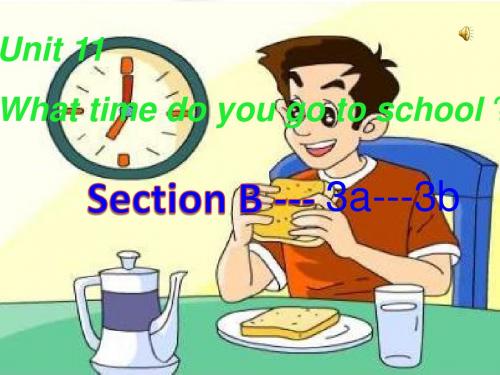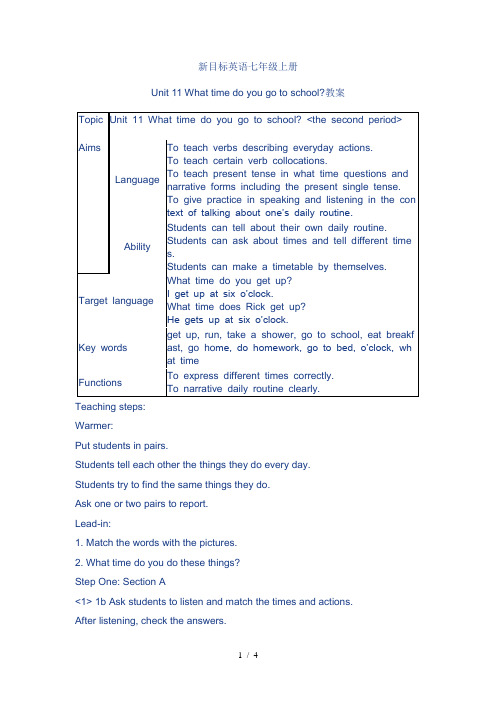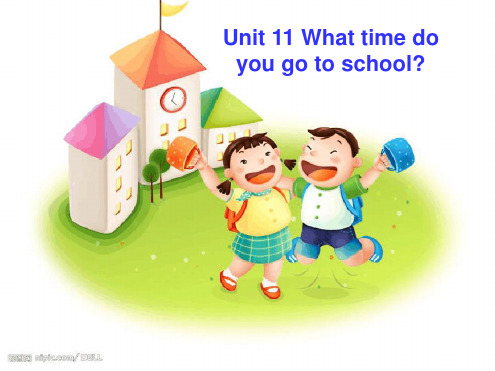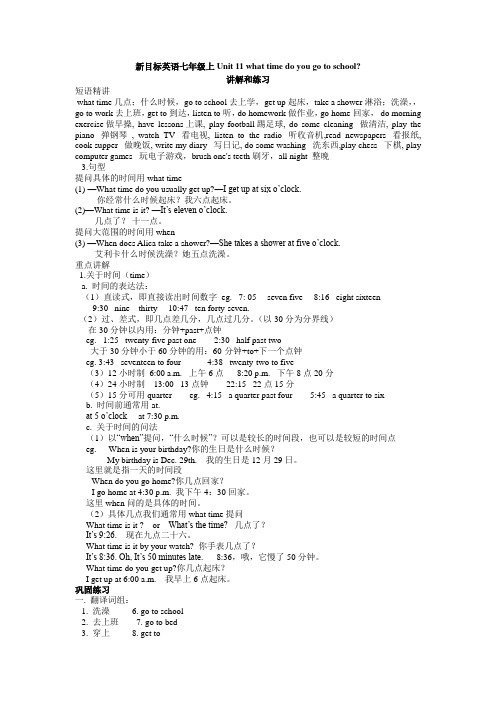人教新目标《英语》七年级上册 U.11 What time do you go to school?
- 格式:ppt
- 大小:2.40 MB
- 文档页数:21



新目标英语七年级上册Unit 11 What time do you go to school?教案Teaching steps:Warmer:Put students in pairs.Students tell each other the things they do every day. Students try to find the same things they do.Ask one or two pairs to report.Lead-in:1. Match the words with the pictures.2. What time do you do these things?Step One: Section A<1> 1b Ask students to listen and match the times and actions. After listening, check the answers.<2> 1c Ask students to do pair work. One is Rick, and the other is the intervie wer.<3> Ask students to talk about Rick’s daily activities.Step Two: Play a game.There’re many kinds of fruit on the blackboard. Students are encouraged to g et them by answering the questions on the back of the fruits. The ways to ans wer them can be different.Step Three: Listening and speaking practice.1.Ask students to see a video and fill in the missing information about David’s daily routine.Dav id’s daily routine:2. Ask some students to say about David’s daily routine.Step Four: Fill in a form.Ask students to write down the information of their own.Ask students to do pair work and fill in their partners’ information.Ask some students to say two or three sentences about themselves and two o r three sentences about their partners.Step Five: Written practice.I usually ______at six o’clock. I have milk and bread for breakfast. After breakf ast, I _____ home and then I______ school by bus. I get to school at seven th irty. I have five classes in the morning. And then I have lunch at ______. In the afternoon I have two classes. I go home at four. I get home at 4:30p.m. I ___ ____at about seven. After dinner, I _______ homework. I _______ at nine thirt y. My life isn’t exciting.Step Six: SummarySummarize the structures learned this class.Step Seven: HomeworkYou are free this Saturday. Please arrange it as you like it to be.课堂教学设计说明这个单元主要学习谈论日常作息活动与时间的表述法。



新目标英语七年级上Unit 11 what time do you go to school?讲解和练习短语精讲what time几点;什么时候,go to school去上学,get up起床,take a shower淋浴;洗澡,,go to work去上班,get to到达,listen to听,do homework做作业,go home回家,do morning exercise 做早操, have lessons 上课, play football 踢足球, do some cleaning 做清洁, play the piano 弹钢琴, watch TV 看电视, listen to the radio 听收音机,read newspapers 看报纸, cook supper 做晚饭, write my diary 写日记, do some washing 洗东西,play chess 下棋, play computer games 玩电子游戏,brush one's teeth刷牙,all night 整晚3.句型提问具体的时间用what time(1)—What time do you usually get up?—I get up at six o’clock.你经常什么时候起床?我六点起床。
(2)—What time is it? —It’s eleven o’clock.几点了?十一点。
提问大范围的时间用when(3) —When does Alica take a shower?—She takes a shower at five o’clock.艾利卡什么时候洗澡?她五点洗澡。
重点讲解1.关于时间(time)a. 时间的表达法:(1)直读式,即直接读出时间数字eg. 7: 05 seven five 8:16 eight sixteen 9:30 nine thirty 10:47 ten forty-seven.(2)过、差式,即几点差几分,几点过几分。
Unit 11 What time do you go to school?Learning objectives1. Skill FocusTalk about routines and say timeListen for times and actionsListen for activitiesLearn to talk daily routinesLearn to ask and answer questions about timesRead a letter introducing your daily routines2. Language Focus(1) 功能句式Talk about daily routines (P65—67)What time do you usually get up?I get up at six o’clock.When does Alice take a shower?She takes a shower at five o’clock.Ask about and say times (P67)What time is it?It’s eleven o’clock.Ask for daily actions (P66)What do you do in the evening?When do people usually eat dinner?(2) 词汇① 重点词汇time, shower, usually, o’clock, work, hour, morning, make, after, bus, listen, , afternoon, evening, homework, letter, around, start, wish, Saturday, hotel, soon, tell, teeth, all, write② 认读词汇o’clock, survey, Jerry, Alicia, Scott③ 词组what time, go to school, get up, take a shower, go to work, get to , listen to, go to bed, do homework, go home, in the morning, in the afternoon, in the evening, eat breakfast, all night, thank for, tell sb. about sth., know about(3) 语法When questionsWhat time is it?Adverbs of frequency3. Strategy Focus(1) Act out conversation in pairs.(2) Encourage students to think over during their study.4. Culture Focus(1) Girls often e nd their letters to other girls with “Love,”….Boys do notdo this when writing to other boys. Boys usually end their letters with a phrase such as “Best wishes.”(2) Let students know about day and night.Teaching materials analyzing and rearranging:教材分析本单元以“What time do you go to school?” 为话题, 共设计了三个部分的内容。
人教版新目标英语七年级上册《Unit 11 What time do you go to school 》教案新目标英语七年级上册《Unit 11 What time do you go to school? 》教案Section A (1a-Grammer Focus )知识目标:1. Words and expressions: get up, run, go to school, eat breakfast, take a shower, what time2. Target language: What time do you get up?I get up at six o’clock.What time does he /she eat breakfast?He/she eats breakfast at seven o’clock.能力目标:1.能灵活运用 What time 询问时间。
2.能自如运用一般现在时谈论人们的日常生活行为。
情感目标:1.培养学生关心朋友,家长的日常行为。
2.培养学生养成良好的行为习惯及珍惜时间的良好习惯。
重点、难点:1.重点:words and phrases, target language2.难点:灵活运用what time…? 来询问人们日常行为。
注意第三人称单数的变化。
学习过程:Step 1 Warm upTask 1: Read and discuss the phrases about daily life of this unit in groups. Then let them show to the teacher. (教师板书)Task 2: Talk about how to read time in groups, then read some time as quickly as they can. (教师帮助纠正错误,如10:15不能加o′clock)Step 2 Presentation1. Lead-in Drill A.The teacher says: “I want to know about your dai ly life. Please answer my question.What time do you usually get up?”(然后引出句型A及答语) A: What time do you usually get up…?B: I usually get up …at…?参考词汇及短语:get up / run / eat breakfast /go to school /go home / do homework /go to bed/brush teeth / do homework…2. Pairwork.Use the drill to talk about their daily life.3. Lead-in Drill B.A: What time does he/she get up …?B: He / she gets up at …The teacher asks: “What time does … get up?”学生可能会回答:“He get up at…”(老师帮助纠正错误导出句型B.强调第三人称单数的变化)4. Play a game “鹦鹉学舌”(小组合作学习)Practice the drills A and B together. (让学生自选所学短语来练习)A: What time do you get up?B: I get up at 6:00.C: What time does B get up ?D: B gets up at 6:00.Step 3 Production1. Play a memory game S1: I get up at 6:30.S2: S1 gets up at 6:30.S3: S1 gets up at 6:30.S4: I run at 6:40.S5: S4 runs at 6:40.S6: S1 gets up at 6:30.S4 runs at 6:40.(教师先做示范)2. Listening practice Listen 1b, 2a and 2b on Page 65-66. Then check the answers.(听前给学生创设听力情景,以便让学生有听力准备)Step 4 Do some exercises一、用所给词的适当形式填空。
教材分析•(能够从以下几个方面实行阐述,不必面面俱到)课标中对本节内容的要求;本节内容的知识体系;本节内容在教材中的地位,前后教材内容的逻辑关系。
本节核心内容的功能和价值(为什么学本节内容),不但要思考其他内容对本节内容学习的协助,本节内容的学习对学科体系的建立、其他学科内容学习的协助;还应该思考通过本节内容的学习,对学生学科水平甚至综合素质的协助,以及思维方式的变化影响等。
本单元主要讲解的是时间,这是第二课时----- 听说课的教学。
在复习第一课时间表达的基础上,学会如何使用时间,学会提问时间和回答。
通过图片的什么时间该干什么,让学生懂得珍惜时间,了解时间的重要性。
懂得只有珍惜时间持续努力的人才能获得成功。
学情分析(能够从以下几个方面实行阐述,但不需要格式化,不必面面俱到)教师主观分析、师生访谈、学生作业或试题分析反馈、问卷调查等是比较有效的学习者分析的测量手段。
学生认知发展分析:主要分析学生现在的认知基础(包括知识基础和水平基础),要形成本节内容应该要走的认知发展线,即从学生现有的认知基础,经过哪几个环节,最终形成本节课要达到的知识。
学生认知障碍点:学生形成本节课知识时最主要的障碍点,可能是知识基础不足、旧的概念或者水平方法不够、思维方式变化等。
对于七年级的学生来说,所学知识有限,对于生活中的一,些事件可能更感兴趣,抓住学生这个特点,充分调动他们的积极性,就能事半功倍。
学生在第一课时已经学过了时间表达方式的基础上,本节课主要是学习如何使用,通过形象生动的图片来学习和操练,在教学中需要很好的数词基础。
教学目标(教学目标的确定应注意按照新课程的三维目标体系实行分析)教学目标:1. 知识目标(1) 词汇:Nouns of the action words : get up, run , take/have a shower , eat/have breakfast, go to school(2) 句型:a. I/They get up at 6 : 00b. He/She runs at 6 : 15c. Do you/they take a shower at 6;30?Yes, I/they do. No, I/they do not.d. Does he/she eat breakfast at 7 : 00?Yes , he/she does. No , h r e/she does not.e. What time do you/they get up?f. What time does he/she run?The usage of pers onal pronouns and verbs.2. 技能目标(1) 描述什么时间做什么.(2) 学会问和回答什么时间做什么.(3) 学会用“what time ”提问和回答时间.3. 情感目标通过描述什么时间做什么,询问和回答什么时间做什么,教育学生遵守时间,更加要懂得珍惜时间,抓住青春的大好年华, 努力学习,实现自身价值。